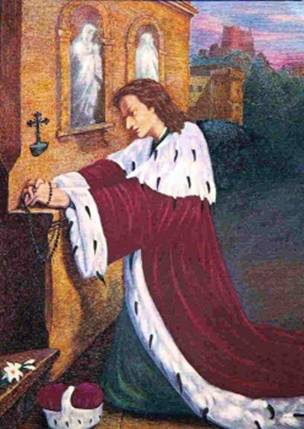
THE VOICE OF INTERNATIONAL LITHUANIA
|
VilNews has its own Google archive! Type a word in the above search box to find any article.
You can also follow us on Facebook. We have two different pages. Click to open and join.
|
SAINT CASIMIR
1458 – 1484

The young prince, Casimir
died at the age of 25 on the 4th of March 1484.
St. Casimir, Lithuania's only Saint, is celebrated on the 4th of March (his death day). This celebration is the origin of the nation's annual Kaziukas Fair.
After his death, St. Casimir was so cherished by Lithuanians that stories of his life and miracles quickly went beyond the church walls and spread through the population and became tales and legends, hence no wonder that he has been so much remembered and celebrated, since the 17th Century primarily through the Kaziukas Fair.
St. Casimir was a true Lithuanian by birth, descending from the famous and respected Gediminaitis clan. The Lithuanian grand dukes Kestutis, Algirdas, Vytautas the Great and others belonged to this family. St. Casimir's father was Kazimieras Jogailaitis who ruled Lithuania (later along with Poland) from 1447.
Kazimieras Jogailaitis married the daughter of Emperor Albrecht II, descended from the Habsburg family. They had six sons and six daughters. Casimir was the second son, born in 1458. He was renowned for a life of great piety, good works and virtue. Upon contracting tuberculosis, he died at the age of 25 on the 4th of March 1484 in the city of Gardinas. He was buried in Vilnius.
Shortly after his death, people started coming in large numbers to visit the holy prince's tomb and pray for intercession with God. His body was associated with numerous miracles and blessings from God. The process to canonize (declare a saint) St. Casimir was begun soon after his death, but for various reasons was delayed until 7 November 1602 when Pope Clement VIII officially proclaimed St. Casimir's feast on the church calendar. It was believed that Casimir had been canonized by Pope Leo X (before 1521) and that Clement VIII merely officially confirmed the fact.
People appealed to their saint at times of various misfortunes. His first miracle is considered to have been his apparition in 1518 at the Dauguva River during the war with Moscow. A large Russian army had assembled and threatened the city of Polotsk. A rather small force of Lithuanians stood to defend the city and fortress. The Lithuanians had to cross the swollen Dauguva River. Unable to find other help, they prayed to the saintly prince to intercede. St. Casimir is said to have appeared to the Lithuanians astride a white horse, wearing a white cloak. He urged the army to fight and rode first into the roaring river. The Lithuanians followed his example, fought fiercely and defeated Moscow's troops. The news of the prince's miraculous apparition and the victory spread throughout the country. The miracle was investigated by bishops of that time and confirmed as authentic. The very fact that St. Casimir came to help in a battle against Lithuania's eternal enemy Moscow elevated him even higher in the eyes of the Lithuanians. The saint became a symbol of the fight against the Russians and Russian Orthodoxy.
Such veneration, so closely linked to anti-Russian feelings, did not go unnoticed by Russia which often occupied Vilnius. Whenever the Russians approached the city, St. Casimir's relics were hidden and taken outside the city; after the danger had passed they were again returned to the church. The Russians made every effort to prevent St. Casimir's veneration; they banned his feast, but were unable to squash the people's enthusiasm. Thousands gathered annually on the 4th of March to pray at the tomb of their beloved saint.
The first church named after St. Casimir was built in Lithuania in the middle or the end of the 16th century near the town Ukmerge. It was built by the Jesuits. At approximately the same time, a church in the saint's honour was built in Vilnius. In Lithuania there are some twelve churches named for St. Casimir.

St. Casimir's Church in the centre of Vilnius is the oldest
Baroque church in Vilnius.
- Bookmark :
- Digg
- del.icio.us
- Stumbleupon
- Redit it
VilNews e-magazine is published in Vilnius, Lithuania. Editor-in-Chief: Mr. Aage Myhre. Inquires to the editors: editor@VilNews.com.
Code of Ethics: See Section 2 – about VilNews. VilNews is not responsible for content on external links/web pages.
HOW TO ADVERTISE IN VILNEWS.
All content is copyrighted © 2011. UAB ‘VilNews’.

 Click on the buttons to open and read each of VilNews' 18 sub-sections
Click on the buttons to open and read each of VilNews' 18 sub-sections 



[…] Read more… Category : Front page […]